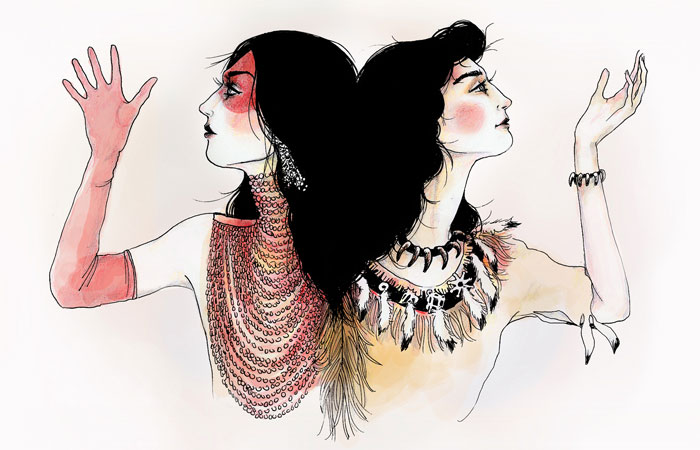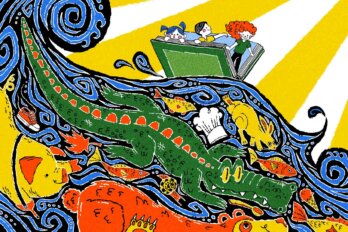In late 1892, Emily Pauline Johnson, a prim thirty-one-year-old bluestocking, made her first appearances as her alter ego, Tekahionwake, decked out in a leather dress, moccasins, and all the other accoutrements a Victorian audience might expect a Native woman to wear. For the better part of the previous year, Johnson, a half-Mohawk, half-English poet, had been reciting her work in the salons of English Canada. She was building momentum in the world of letters for her romantic naturalist ballads, and was renowned for her beauty, her striking stage presence, and her impassioned recitals. She had developed a niche as one of Canada’s most accomplished New Women, a cohort of late nineteenth-century feminists who were shedding the sexist shackles of the era. But as her act gathered steam, she created the onstage persona of Tekahionwake, an exaggerated, heightened riff on existing stereotypes, but also an ambassador to familiarize theatregoers with the conditions suffered by Native women.
She ordered a buckskin costume from the Hudson’s Bay Company; ironically, she couldn’t find an authentic outfit on the Six Nations reserve outside of Brantford, Ontario, where she grew up. The dress came with moccasins and a beaded belt adorned with moose hair and porcupine quills. She tore off one sleeve and replaced it with rabbit pelts, then completed the outfit with a hunting knife. (She would later add a bear claw necklace, a wampum belt, and a Huron scalp that had belonged to her grandfather.) Johnson’s audiences ate it up, and she became one of the country’s first celebrities, her distinctive costume generating the same tittering, slightly scandalized, and utterly enthralled reactions as Madonna’s cone bra or Lady Gaga’s meat dress would provoke a hundred years later.
For the next seventeen years, Johnson toured the world as Tekahionwake. She was billed by her promoter, Frank Yeigh, as the Mohawk Princess (a marketing ploy she used throughout her career), and although her branding played into the stereotypes, her stories broke them down. Her tales and poems gave agency to First Nations women, hooking her audience with a mix of poise and campy histrionics. In a trademark flourish, she shed the buckskin during intermission and returned in a staid silk evening gown and pumps, eliciting gasps from spectators as they marvelled at the transformation. The two modes of dress served as an external manifestation of Johnson’s own dual identity: the name Tekahionwake, which she came to use in both her performances and her published poetry, means “double life” in Mohawk.
A century has passed since she published her signature book, Flint and Feather, her most tangible legacy. The volume came out a year before she succumbed to breast cancer in 1913, and in the period leading up to her death she wrote new material for it and selected previously published poems to be added. It became one of the bestselling poetry books in the country, and remains as a self-curated retrospective.
The truth is, though, that Johnson was a lousy poet. Her poems are cloying, sentimental pap, full of clichés and purple images that trip clumsily over her clunky meter. Rather than a literary landmark, the book stands as a cultural artifact, a physical record of how she was seen by herself and by the world. Her most significant work, her captivating stage persona, has been lost to history. She lived at the dawn of the modern era, but her approach was decidedly postmodern. Anticipating her contemporary descendants (artists like Kent Monkman and Rebecca Belmore), she played along with white notions of Native identity, only to shatter them along the way.
If Johnson were alive now, no one would mistake her for a poet. She would be seen as a performance artist, and her audience would be in on the conceit. They would be wise to her fluid identity, and her calculated, sly undermining of the dominant stereotypes. They would recognize that her brilliance lay not in the words she spoke, but in how she articulated them, and how, simultaneously, she displayed the public image she had fashioned for herself.
Johnson came by her bifurcated identity honestly: among her ancestors were several Mohawk notables who straddled the border between the Native and white communities. Jacob Tekahionwake Johnson—her great-grandfather, and her alter ego’s namesake—acquired his English name from Sir William Johnson, a British superintendent and Jacob’s godfather, who insisted on baptizing the newborn boy.
Pauline’s father, George, came from a long line of Mohawk chiefs. Foreshadowing his daughter’s cunning manipulation of identity, he would shed and adopt whichever persona best suited his purpose. He was a dashingly handsome man whose grace, manners, and fluency in English endeared him to members of the white community with whom he had dealings. He worked as an interpreter for a local parish and various church missionaries, translating sermons and prayer books into Mohawk.
In her authoritative 2002 biography of Johnson (also titled Flint and Feather), historian Charlotte Gray described how, upon meeting her future husband, Pauline’s mother, Emily Howells, a pale-eyed Englishwoman, was surprised to find George dressed in a plain, European-style outfit of cloth pants and a woollen shirt. To her family back home, Emily described him as “handsome, noble, and the kindest man who ever lived,” with lips “like Cupid’s bow.” Later, after the couple’s wedding in Kingston, Ontario, in 1853, Gray reports that the whole town came out to gawk at the processional when it arrived in Toronto, expecting a bacchanalia of feathers and tomahawks. Instead, George wore a dove-grey frock coat in the latest fashion, with a starched collar, a silk cravat, and white gloves.
Pauline was born in 1861 and grew up on her family’s sprawling eighty-hectare estate, Chiefswood, on the Grand River. George had built the house as a wedding present for Emily, with two front doors, one leading to a thoroughfare bustling with horse-drawn carriages on their way to Brantford, the other opening onto the riverbank, where ferries and canoes glided by on the current.
Emily raised her children with deference to Victorian manners and decorum, and Pauline was educated by English governesses and at a school in Brantford; she spent her childhood devouring Keats, Wordsworth, and Milton. Meanwhile, she relished her father’s discussion of Mohawk traditions and rituals, and sat rapt as her grandfather, Chief John “Smoke” Johnson, told stories of shamans and ghosts. (For all her father’s efforts to acquaint his children with their heritage, they never learned to speak Mohawk.) Like Huck Finn’s raft, Chiefswood lived forever in Pauline’s memory as a space of racial transcendence, where Natives and whites could coexist peacefully.
But in the early days of Confederation, already tense relations between white settlers and Native populations were growing even more fraught: the new Canadian dominant class sought to acquire and develop as much Native land as possible, and the Indian Act, legislated in 1876, rendered all Aboriginal peoples of Canada as ghettoized non-citizens whose very identity was determined by the government. The authorities’ exploitation—assimilation attempts via the residential school system, disenfranchisement, lack of property rights—was matched by social and cultural denigration. Popular culture depicted Native men as primitive or savage (think of the menacing drunk, Injun Joe, in The Adventures of Tom Sawyer, or the noble “chiefs” paraded in Buffalo Bill’s Wild West), while women were dismissed as promiscuous, spineless “squaws.” Pocahontas was adapted as a role model of Native femininity, usually because her story was interpreted as one of assimilation.
With her curly brown hair, grey eyes, and light skin, Johnson could have passed as white, but throughout her life she insisted on asserting her Mohawk heritage. Her need to exaggerate her nativeness in her persona was a conscious act, but it was also likely born of the fact that Indigenous people were—and still are—the only racial group to be legally mandated in Canada. First Nations people had to prove their heritage by establishing that they were biologically descended from a member of an Indian band, which entitled them to certain rights and protections, but diminished their individual agency and relegated them to being glorified wards of the government. (Even the blood-determined “science” of status wasn’t fixed: a Native woman could lose those protections by marrying a non-Native.)
In an 1892 essay entitled “A Strong Race Opinion: On the Indian Girl in Modern Fiction,” Johnson called out white writers for their generic, latently racist depictions of Native femininity. Without fail, she says, the Indian girl, always named Winona or some such, has no tribal specificity, merely serving as a self-sacrificing, mentally unhinged outlet for the white hero’s magnanimity. Johnson entreated writers to give their “Indian girl” characters the same dignity and distinction as they did their white characters. “Let the Indian girl in fiction develop from the ‘dog-like,’ ‘fawn-like,’ ‘deer-footed,’ ‘fire-eyed,’ ‘crouching,’ ‘submissive’ book heroine into something of the quiet, sweet womanly woman if she is wild, or the everyday, natural, laughing girl she is if cultivated and educated; let her be natural,” she wrote, “even if the author is not competent to give her tribal characteristics.”
In her own act, Johnson drew from the dominant white theatrical modes. Melodrama, the most popular form in the late nineteenth century, was characterized by an excess of spectacle, histrionic gestures, and amplified emotions. With her over-the-top theatrics, she was a hit with crowds hungry for sentiment. One of her most popular stories, “A Red Girl’s Reasoning,” tells of a young half-Indian woman who leaves her husband after he refuses to recognize the legitimacy of her nation’s rituals; another heroine, the half-Cree Esther of “As It Was in the Beginning,” kills her faithless white lover.
Delivering her monologues, Johnson made full use of the stage, pacing, crouching, and creeping as she regaled her rapt audiences with stories of jilted heroines and cowardly men. She unleashed battle cries, radiating commanding magnetism. People may have come to see Pocahontas, but they were presented with an entirely different image of Aboriginal womanhood. Then, upon her return to the stage after intermission, attired with delicately pinned hair and a silk gown, she accomplished something even more astounding: she introduced them to the other aspect of herself, conveying a novel, mutable approach to identity, and demonstrating that when it came to her public image she was the one in charge.
Johnson stopped touring in 1909. When she developed breast cancer, a certain death sentence in the early twentieth century, bad health led to her retirement. She settled in Vancouver and continued to write (adapting many of her later works from stories told to her by her friend, the Squamish chief Joseph Capilano). She died in 1913, three days before her fifty-first birthday.
Her earnest poetry proved no match for the new nihilistic, hyper-conscious modernist literature produced by World WarI, and she was quickly and unceremoniously forgotten. In the past few decades, however, she has been reclaimed by the feminist community as an early member of its ranks. Gray’s biography became a bestseller when it was released a decade ago; and Margaret Atwood is working on her first libretto, Pauline, commissioned by City Opera Vancouver.
Johnson’s playful and political take on dual identity anticipated the work of several modern First Nations artists. Brian Jungen, a Vancouver sculptor of mixed Swiss and Dunne-Za ancestry, makes Native-style masks out of Nike shoes, and totem poles out of backpacks. Sonny Assu, is part Ligwilda’xw and, working out of Montreal, uses a pop art aesthetic to riff on Aboriginal issues. And Rebecca Belmore, the first Indigenous artist to represent Canada at the Venice Biennial, in 2005, has used photography and installation art to illustrate the plight of Native women.
But in the contemporary art world, Miss Chief Eagle Testickle is Tekahionwake’s most direct descendant, an oiled-up, glossy-haired, gyrating Indian warrior princess and the alter ego of Toronto visual and performance artist Kent Monkman, who, like Johnson, is biracial. Dressed in high heels, big feathers, and tiny loincloths (sometimes in trademark Hudson’s Bay Company stripes), Miss Chief is a hybrid of stereotypes: the modern-day drag queen, the early twentieth-century Native American actress Molly Spotted Elk, and Cher (the character is partly a send-up of Cher’s 1973 single “Half-Breed”). Like Tekahionwake, Miss Chief is entirely in command of her sexuality, unwilling to be exploited by the European male. Appearing in videos and many of Monkman’s paintings, she reverses the lascivious gaze, seducing and ravishing the European settlers and depicting them in various states of undress and homoerotic acts. In one of her early film roles, in a short called Group of Seven Inches, she lures a pair of white men to a cabin, liquors them up, and engages in some light BDSM. Speaking of that famous septet, Monkman’s contributions to a 2005 exhibit at the Ottawa Art Gallery disrupted the placid Canadian landscape of Lawren Harris and the like, depicting a cowboy and an Indian in mid-coitus among the shadows of those revered mountaintops.
In other works, Monkman’s approach is similar to Johnson’s take on sentimental Victorian poetry. His landscapes mimic the classical colonial paintings that romanticized the noble savage, but with a twist. His paintings are sublime and swathed in vibrant colour—just like those of early American artists Albert Bierstadt, George Catlin, and Eastman Johnson—except for the presence of the drag queen in a pink feathered headdress.
Johnson was many things: performer, intellectual, Native activist, feminist, and (though not a very good one) poet. But as enterprising as she was, she was also an idealist. Her proud biracial identity, within which her Aboriginal and European selves peacefully coexisted, constituted an anomaly in an era when race was considered a fixed trait. The unified persona she presented onstage, nurtured in her childhood and reflected in her writings, represented more than just an amplified, campy theatrical ruse: it was a vision of what she imagined for Canada. For seventeen years, the stage afforded her a place where she could project an idealized self, and, where, as in the cloistered utopia of Chiefswood, she could envision an idealized nation. Surveying Canada’s beaming multiculturalism today, flawed as it may be, Johnson seems like quite an oracle.
This appeared in the July/August 2012 issue.






